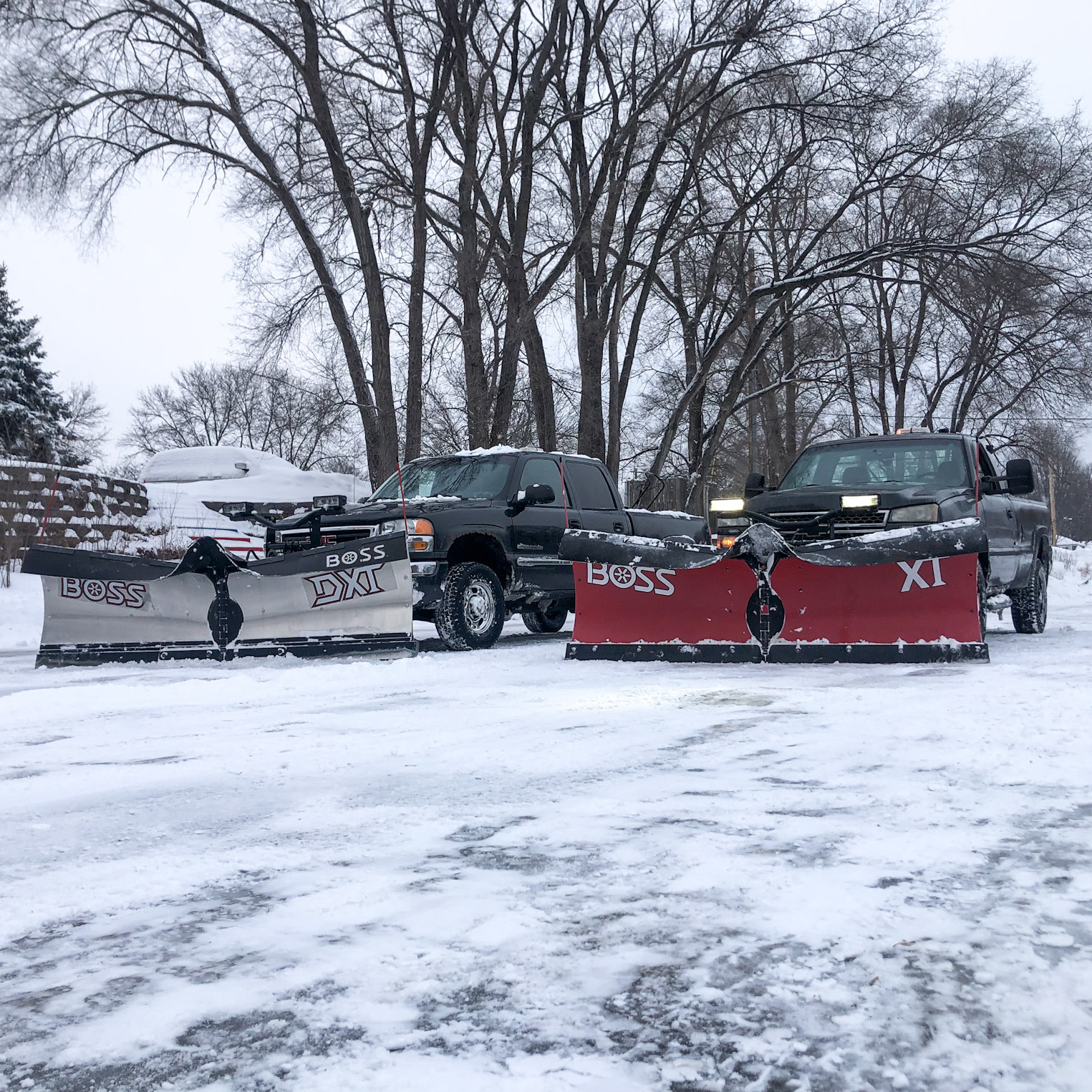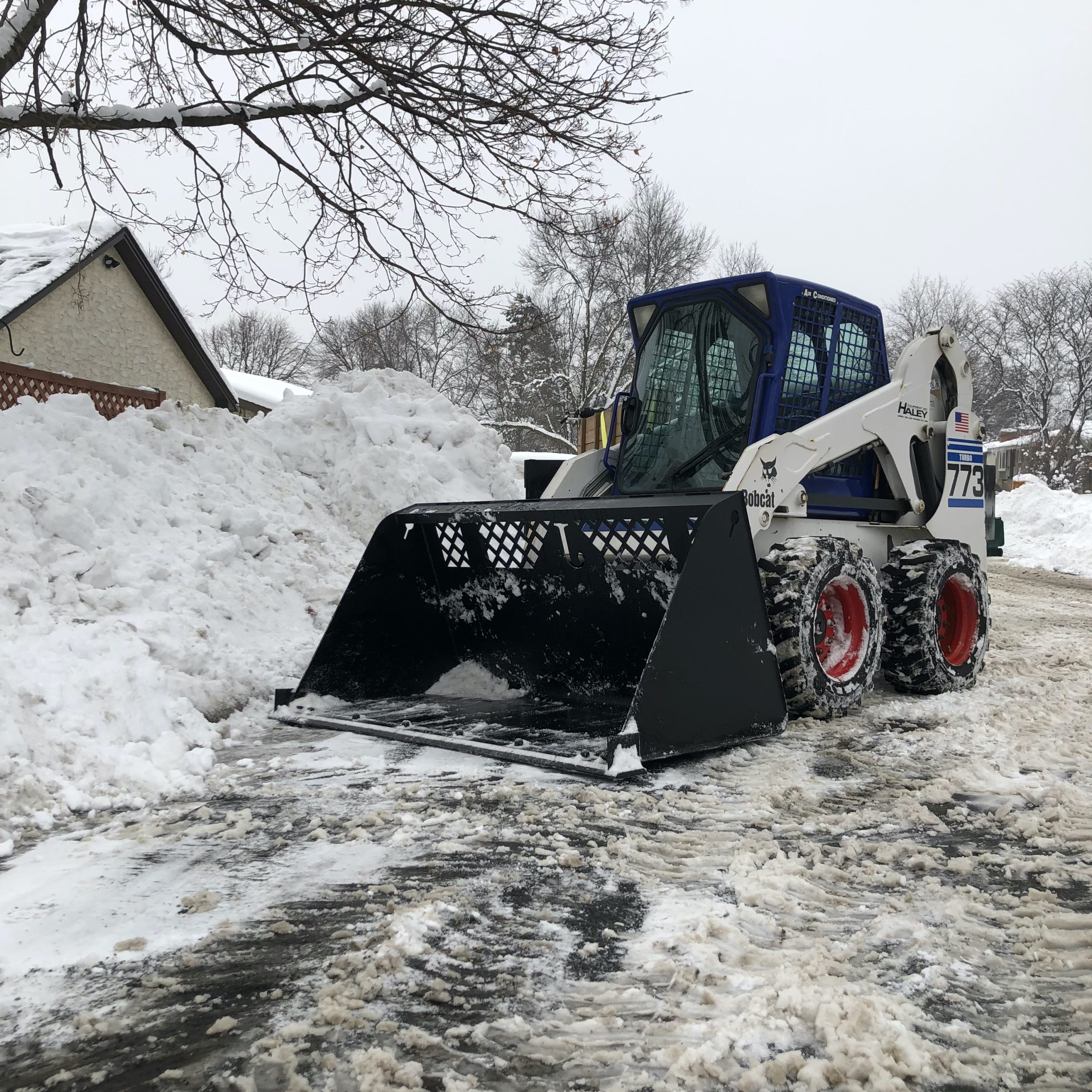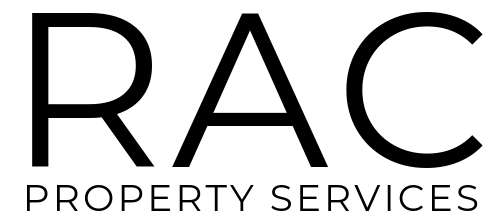Getting back to bare pavement doesn’t have to wait until spring
Faster Working Time
Liquids work 3-4x faster than rock salt because they don’t have to go through a phase change.
Liquids are better for the Environment
Liquid Brine uses 1/3 the amount of salt compared to spreading conventional rock salt
Reduced Janitorial Costs
Liquids do not track inside and make a mess like rock salt.
Liquid Deicing, The Basics
Why Liquid Deicing and How It Works
Safety
Liquids work faster, typically 3-4x faster than rock salt alone. Getting down to bare pavement faster can aid in preventing very costly slip-and-fall accidents.
Can Be Applied As a Pre-Treatment or Post Treatment
A Pre-treatment prevents the bond of snow and ice to the pavement, and allows plows to scrape cleaner. Post-Treatments bring parking surfaces back to bare pavement.
A Better Alternative to Rock Salt
Liquid deicing is a tool or replacement alternative to the traditional methods of spreading rock salt or granular material. Simply put, liquids start working immediately to help get you back to a
safe surface.
Lower Janitorial, Maintenance and Infrastructure Costs
Liquids are up to 80% less corrosive than standard rock salt, resulting in less property damage.
Liquids do no track into buildings as easily as rock salt.
A Process That Makes Getting a Clean Lot Easy
Getting your parking lot cleared doesn’t have to be hard. It just takes 3 steps
Step 2
Get An Estimate
Answer a few questions about your property, scope of work and site needs. Get an estimate emailed to you.
Step 3
Sign for Service
Sign a service agreement and have a clean parking lot all winter long.
Frequently Asked Questions
Others have had these questions, maybe you have them too
What is "Brine?"
Liquid deicing, or Brine, is a tool or replacement alternative to the traditional methods of spreading rock salt or granular material. Simply put, liquids start working immediately to help get you back to a safe surface, cause less corrosion and infrastructure damage to your property and are better for the environment.
Brine, is commonly referred to as “Liquid Brine,” “Salt Brine,” or just “Brine.” Brine is salt dissolved in water to form a saltwater solution. Liquid Brines are what we use for treating roads, parking lots and sidewalks. They are mixed to a 23.3% Salinity, at 2.28 pounds of pure salt per gallon of water. Too little salt or too much salt will make them ineffective.
When is Brine Applied?
Liquid deicing can be applied to surfaces on a 1) Pre-treatment 2) Post-treatment or 3) Interstorm treatment. Review each section below to learn more about when and why each application is used as you think about what might be a good fit for your property.
References made to application rate are in gallons per acre (GPA) being applied. This application rate is vitally important so that we are not over-applying salt and wasting materials.
What is "Pretreatment?"
Pre-treatment applications are made before the storm to prevent the bond of snow and ice to the surface and prevent a mild amount of accumulation. This allows for easier mechanical removal of snow and ice and thereby the use of less salt after your plows are finished.
• Standard Application Rate: 40-50 GPA (Gallons per Acre)
• Goal: Broad, even coverage to reach all the pores in the surface.
• Timing: 24-48 hours before a storm (can be much longer if using a quality additive).
What is an INTERSTORM APPLICATION?
Interstorm applications can be necessary for extended events or events with heavy moisture content such as rain to sleet. The best approach is to have your standard pre-treatment application applied and dried before the rain begins. A secondary application around the time rain turns to freezing rain or snow will help prevent icing over your surfaces. These applications will help prevent the bonding of moisture to pavement to aid your plows and shovels in getting you back to a safe surface. Interstorm applications can also be useful during long duration snow events, where the initial pre-treatment is no longer effective in preventing snow and ice.
• Standard Application Rate: 60-80 GPA (Gallons per Acre)
• Goal: “Refresher” application to keep surface protected from formation of ice or snowpack.
• Timing: Around the time rain turns to freezing rain or halfway through a long duration snow event.
Preventing ice or snowpack accumulations with liquids is much easier than getting rid of it once it
has frozen. Don’t panic, if timing does not allow for interstorm treatments. An increase to your
final application rate to 100-120 GPA will likely meet site condition needs.
What is "Post Treatment?"
Post-treatment applications are a viable replacement for rock salt, treated salt and bagged sidewalk products. This application is done after snow plows have finished and you need to address any remaining residual snow and ice.
• Standard Application Rate: 80-100 GPA
• Goal: Blast liquids with pressure to reach the surface.
• Timing: As soon as plows are finished.
How and why do liquids work faster than rock salt?
When a grain of salt is sitting on the pavement is reacts with moisture in the air and on the pavement to go through a phase change. It turns from a solid granular to a liquid melting snow and ice with it. The liquid it creates is actually salt water, a brine. Phase changes take a lot of energy and therefore a lot of TIME.
To compensate for this rock salt is typically over applied. Minnesotas Pollution Control Agency recommends 160-200 Ibs of rock salt per acre to achieve safe conditions. This roughly equates to 1 salt grain every 11 inches, about the size of a dinner plate. However, because of the phase change it can take 24-48 hours before safe condions are met. The standard in the Ice Managemetn Industry is to over apply rock salt to decrease the amount of time for safe conditions. Average application rates for rock salt is 800-1,000 Ibs per acre. This equates to roughly one grain of rock salt every 1.5″-2″ apart.
We can skip this phase change by not applying rock salt, and applying brine to begin with since rock salt turns into brine. Skip the phase change, reduce the amount of salt needed, brine starts working 3-4x faster than rock salt. Getting back to bare pavement faster can reduce the likelihood of slip-and-fall accidents.
Why are liquids better for the environment?
Better for the environment:
– 75% of application is water.
– Brine uses 1/3 the amount of salt as a typical rock salt application, which means less salt in the environment, soils and waterways.
– Liquids stay where you apply them, even on vertical surfaces.
– No bounce and scatter during application as with grnaular
• No leftover residue or bulk salt sitting on the surface provides better looking sites.
• Doesn’t kill vegetation like granular salt.
• Doesn’t damage soils like bulk salt storage bins may.
How do liquids reduce the cost of property damage?
Liquids can lessen chloride’s hidden costs. A single ton of salt applied on a property can cause between $800-$3,000 of long-term infrastructure damage according to Fortin Consulting Inc. This long-term damage comes from things such as concrete, steel door jambs, structural steel, aluminum, bricks, light poles, signs, underground plumbing, landscaping, masonry, retaining walls, turf and more. Liquids reduce the amount of chlorides applied and the likelihood of it coming into contact with these costly infrastructure assets.
Liquids help reduce janitorial costs. Liquids do not track into buildings like rock salt, ice melt or even calcium chloride pellets. Janitorial staff will be able to attest to that almost immediately upon conversion to liquids–fewer rug changes and less flooring maintenance and wasted time for janitorial staff.
What are "additives?"
Standard untreated rock salt only works above 15 degrees F. Additives lower the melting temperature giving protection against refreezing after application. They include stabilizers (this helps reduce “migration” by helping the product stay in place through traffic and wind), and corrosion inhibitors (protects equipment and property from corrosion damages typically seen with rock salt).
Solutions are custom mixed every storm based on conditions (Forecasted air temps & humidity) with “Brine” (Salt + Water) and “Additives” to differing blends, typically 95/5, 90/10, or 80/20, this allows for us to apply effective melting down to -30F with an 80/20 blend.
Additives can be used along with brine to supercharge your application. Ready-made additives have many key ingredients to help prevent issues that can be caused by using rock salt or salt brine alone.
These key ingredients include:
• Tackifiers to help the product hold to the surface through traffic, wind and rain.
• Corrosion inhibitors to protect your equipment and customer’s property. These inhibitors
can make applications up to 80% less corrosive than rock salt alone.
• Polymers that aid with traction even when there might be a glaze on the lot and help deform
ice particles that do form to make ice less slippery (rough ice vs. smooth ice).
• Organic content that substantially lowers the freezing point of water and also help deform ice
particles as they form. At temperatures where untreated rock salt becomes ineffective, salt
brine blended with quality additives will continue working at much colder temperatures. In
addition, this organic content means that even when your chlorides are diluted, you still have
protection against refreeze.
Preventing "Over Application"
Our truck-mounted application is GPS controlled which allows us to achieve a +/- 3% accuracy, which means the product can’t be easily over-applied as with rock salt spreaders.
Are there times when Liquid Brine should NOT be used?
If high winds are forecasted, we recommend NOT spraying liquid deicing until the winds have subsided. Liquids on a parking lot with high winds will act as a magnet for blowing snow, rather than allowing it to blow over the parking lot without sticking to the surface. However, the same is true for traditional rock salt applications, applying salt when high winds are forecasted is also not best practice.
It’s best to let the snow stay dry and blow across the parking surfaces, then treat when winds have stopped.
Billing. How does billing work for Liquids?
If you’ve had your parking lot salted before you are probably used to getting bulled “per ton” or “per pound” applied. This is the most common way for contractors to bill for spreading salt.
Liquids are similar, we bill per gallon applied. Our spray trucks are all equipped with flow meters that measure how much liquid is applied at each site. Different application rates are needed for different site and weather conditions. You can read more in the Pretreatment Post-treatment and Inter-storm sections above to get an idea of typical application rates.
Gladly Serving The Columbia Heights Area
Columbia Heights, St. Anthony, New Brighton, and Southern Fridley
Other Services

Residential Snow Removal
We offer Residential packages starting with Drive Way Only snow removal (Our most popular option). Other services can be added on to meet your needs. Per push contracts or seasonal contracts are available as route space allows.

Commercial Snow Removal
We offer Custom Commercial packages, with minimum triggers as high as 1″. Contact for a quote on your commercial property.

Bobcat Snow Removal
Running out of room to pile snow? We can move and re-stack piles on your site to make more room or gain back parking spaces.
Pricing for Bobcat work at $156/hr with a 1hr minimum
